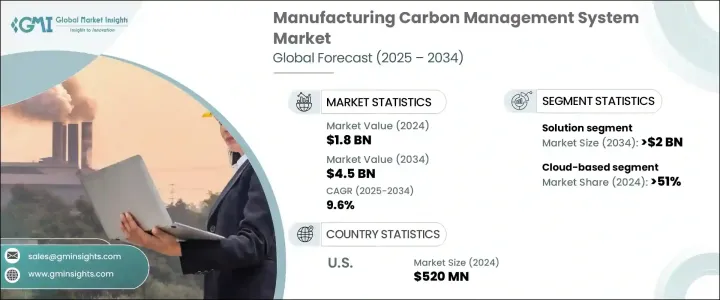
|
시장보고서
상품코드
1755368
세계의 제조 탄소 관리 시스템 시장 : 기회, 성장 촉진요인, 산업 동향 분석 및 예측(2025-2034년)Manufacturing Carbon Management System Market Opportunity, Growth Drivers, Industry Trend Analysis, and Forecast 2025 - 2034 |
||||||
세계의 제조 탄소 관리 시스템 시장은 2024년에는 18억 달러로 평가되었고, 2034년에는 CAGR 9.6%로 성장하여 45억 달러에 이를 것으로 전망됩니다.
전 세계 정부는 기후 변화 목표를 달성하기 위해 탄소 가격 책정, 세금, 배출권 거래 제도, 의무적인 온실가스(GHG) 보고와 같은 메커니즘을 통합한 더 엄격한 법안을 도입하고 있습니다. 이에 대응하여 기업들은 탄소 관리 솔루션을 점점 더 많이 채택하고 있으며, 제조업체들은 환경에 미치는 영향을 최소화하는 기술을 도입하도록 촉진하고 있습니다.

그러나 센서, 자동화 도구, 에너지 효율적인 기계와 같은 수입 부품에 대한 무역 관세는 탄소 관리 시스템 업그레이드 비용을 잠재적으로 상승시킬 수 있습니다. 이는 중견 제조업체의 접근을 제한할 수 있지만, 기업들이 수입 비용 상승의 영향을 완화하기 위해 노력함에 따라 국내 혁신을 촉진하고 현지에서 공급되는 탄소 관리 솔루션에 대한 수요를 증가시킬 수도 있습니다. 한편, AI, 데이터 분석, IoT, 블록 체인 등의 기술 발전으로 탄소 관리 솔루션의 효율성이 향상되어 기업들이 배출량을 모니터링, 관리 및 보고할 수 있게 되었습니다. 이러한 혁신은 산업 전반에 걸쳐 이러한 시스템의 채택을 가속화하고 있습니다.
| 시장 범위 | |
|---|---|
| 시작 연도 | 2024년 |
| 예측 연도 | 2025년-2034년 |
| 시작 금액 | 18억 달러 |
| 예측 금액 | 45억 달러 |
| CAGR | 9.6% |
탄소 관리 시스템 시장의 솔루션 부문은 규제 요구의 증가와 강력한 환경 보고의 필요성에 힘입어 2034년까지 20억 달러에 달할 것으로 예상됩니다. 이 솔루션은 실시간 배출 데이터 제공, 탈탄소화 시나리오 모델링 지원, GHG 프로토콜 및 ESG 공개와 같은 보고 프레임워크 호환성을 통해 기업이 규제 준수 및 환경 책임 입증을 위해 필수적인 기능을 제공합니다. 기업들이 엄격한 지속 가능성 규제를 충족하고 탄소 배출량을 줄이기 위해 노력함에 따라 이러한 고급 도구 수요는 계속 증가할 것입니다.
클라우드 기반 탄소 관리 플랫폼 부문은 2024년까지 51%의 점유율을 차지했습니다. 이 플랫폼은 기업이 탄소 배출량을 실시간으로 추적하고 분석할 수 있는 유연하고 확장 가능한 솔루션을 제공하기 때문에 특히 매력적입니다. 이러한 플랫폼은 추적 기능을 지원할 뿐만 아니라 업계의 지속 가능성 목표 및 환경 표준을 준수하기 때문에 투명성을 높이고, 성과를 개선하며, 진화하는 규제 요건을 충족하고자 하는 기업에게 필수적인 도구입니다.
미국의 제조 탄소 관리 시스템 시장은 급속한 기술 혁신, 산업 변화, 기후 변화 완화에 대한 강조가 높아짐에 따라 2024년에 5억 2,000만 달러의 매출을 달성했습니다. 이 시장은 환경, 사회, 거버넌스(ESG) 원칙의 채택이 증가하고 탄소 발자국 공개에 대한 법적 압력이 강화됨에 따라 더욱 활성화될 것입니다. 미국 기업들이 지속 가능성 목표와 규제 요건을 충족하기 위한 압력이 증가함에 따라 탄소 관리 솔루션 시장도 계속 성장세를 보이고 있습니다.
세계의 제조 탄소 관리 시스템 업계의 주요 기업으로는 Accuvio, Carbon Footprint Ltd., Dakota Software, Enablon, EnergyCap, Engie, Enviance, Envirosoft, ESP, IBM, Intelex, Isometrix, Locus Technologies, NativeEnergy, Salesforce, SAP, Schneider Electric Consultants 등이 있습니다. 세계의 제조 탄소 관리 시스템 업계의 기업들이 시장 입지를 강화하기 위해 채택한 주요 전략에는 AI, 블록 체인, IoT와 같은 최신 기술의 통합이 포함됩니다. 이를 통해 기업은 데이터 추적, 배출 보고 및 지속 가능성 노력을 개선할 수 있습니다. 정부 기관 및 산업 규제 기관과의 전략적 파트너십도 점점 강화되는 환경 정책을 준수하는 데 매우 중요합니다. 확장 가능한 클라우드 기반 솔루션을 제공하고 데이터 분석을 활용함으로써 기업들은 실시간 배출 모니터링 및 투명한 보고에 대한 증가하는 요구를 충족하고 있습니다.
목차
제1장 조사 방법과 범위
제2장 주요 요약
제3장 업계 인사이트
- 생태계 분석
- 트럼프 정권의 관세 분석
- 무역에 미치는 영향
- 무역량의 혼란
- 보복 조치
- 업계에 미치는 영향
- 공급측의 영향(원재료)
- 주요 원재료의 가격 변동
- 공급망 재구성
- 생산 비용에 미치는 영향
- 공급측의 영향(원재료)
- 수요측의 영향(판매가격)
- 최종 시장에의 가격 전달
- 시장 점유율 동향
- 소비자의 반응 패턴
- 영향을 받는 주요 기업
- 전략적인 업계 대응
- 공급망 재구성
- 가격 설정 및 제품 전략
- 정책관여
- 전망과 향후 검토 사항
- 무역에 미치는 영향
- 규제 상황
- 업계에 미치는 영향요인
- 성장 촉진요인
- 업계의 잠재적 위험 및 과제
- 성장 가능성 분석
- Porter's Five Forces 분석
- PESTEL 분석
제4장 경쟁 구도
- 소개
- 기업의 시장 점유율
- 전략적 대시보드
- 전략적 노력
- 경쟁 벤치마킹
- 혁신과 지속가능성의 정세
제5장 시장 규모와 예측 : 컴포넌트별(2021-2034년)
- 주요 동향
- 솔루션
- 서비스
제6장 시장 규모와 예측 : 전개별(2021-2034년)
- 주요 동향
- 클라우드
- 온프레미스
제7장 시장 규모와 예측 : 지역별(2021-2034년)
- 주요 동향
- 북미
- 미국
- 캐나다
- 유럽
- 독일
- 프랑스
- 영국
- 스페인
- 이탈리아
- 아시아태평양
- 중국
- 인도
- 일본
- 호주
- 한국
- 중동 및 아프리카
- 사우디아라비아
- 남아프리카
- 아랍에미리트(UAE)
- 라틴아메리카
- 브라질
- 아르헨티나
제8장 기업 프로파일
- Accuvio
- Carbon Footprint Ltd.
- Dakota Software
- Enablon
- EnergyCap.
- Engie
- Enviance
- Envirosoft
- ESP
- IBM
- Intelex
- Isometrix
- Locus Technlogies
- NativeEnergy
- Salesforce
- SAP
- Schneider Electric
- Trinity Consultants
The Global Manufacturing Carbon Management System Market was valued at USD 1.8 billion in 2024 and is estimated to grow at a CAGR of 9.6% to reach USD 4.5 billion by 2034, attributed to the implementation of stringent environmental policies and rising regulations surrounding carbon management. Governments worldwide are introducing stricter laws to curb carbon emissions, incorporating mechanisms like carbon pricing, taxes, cap-and-trade systems, and mandatory greenhouse gas (GHG) reporting to meet climate change goals. In response, organizations are increasingly adopting carbon management solutions, driving manufacturers to embrace technologies that minimize their environmental impact.

However, trade tariffs on imported components, such as sensors, automation tools, and energy-efficient machinery, could potentially raise the cost of carbon management system upgrades. While this might restrict access for mid-sized manufacturers, it may also drive domestic innovation and increase demand for locally sourced carbon management solutions as companies strive to mitigate the impact of higher import costs. Meanwhile, advancements in technologies like AI, data analytics, IoT, and blockchain are enhancing the efficiency of carbon management solutions, allowing companies to monitor, manage, and report emissions. These innovations are accelerating the adoption of these systems across industries.
| Market Scope | |
|---|---|
| Start Year | 2024 |
| Forecast Year | 2025-2034 |
| Start Value | $1.8 Billion |
| Forecast Value | $4.5 Billion |
| CAGR | 9.6% |
The solution segment of the carbon management system market is anticipated to reach USD 2 billion by 2034, driven by increasing regulatory demands and the need for robust environmental reporting. These solutions offer real-time emissions data, enable decarbonization scenario modeling, and support reporting frameworks like the GHG Protocol and ESG disclosures, which are becoming essential for businesses to stay compliant and demonstrate environmental responsibility. As companies strive to meet stricter sustainability regulations and reduce their carbon footprint, the demand for these advanced tools continues to rise.
Cloud-based carbon management platforms segment will hold a 51% share by 2024. Their ability to offer flexible, scalable solutions that allow businesses to track and analyze carbon emissions in real time makes them particularly attractive. These platforms not only support tracking but also align with industry sustainability goals and environmental standards, making them critical tools for businesses aiming to enhance transparency, improve performance, and meet evolving regulatory requirements.
U.S. Manufacturing Carbon Management System Market generated USD 520 million in 2024, driven by rapid technological innovations, industry shifts, and the growing emphasis on climate change mitigation. This market is further fueled by the rising adoption of Environmental, Social, and Governance (ESG) principles and the increasing legal pressures to disclose carbon footprints. As companies in the U.S. face mounting pressure to meet sustainability objectives and regulatory requirements, the market for carbon management solutions continues to gain momentum.
Key players in the Global Manufacturing Carbon Management System Industry include Accuvio, Carbon Footprint Ltd., Dakota Software, Enablon, EnergyCap, Engie, Enviance, Envirosoft, ESP, IBM, Intelex, Isometrix, Locus Technologies, NativeEnergy, Salesforce, SAP, Schneider Electric, and Trinity Consultants. Key strategies adopted by companies in the Global Manufacturing Carbon Management System Industry to enhance their market presence include integrating cutting-edge technologies like AI, blockchain, and IoT. This helps companies improve their data tracking, emissions reporting, and sustainability efforts. Strategic partnerships with governmental bodies and industry regulators are also vital for compliance with growing environmental policies. By offering scalable cloud-based solutions and leveraging data analytics, firms are meeting the increasing demand for real-time emission monitoring and transparent reporting.
Table of Contents
Chapter 1 Methodology & Scope
- 1.1 Market definitions
- 1.2 Base estimates & calculations
- 1.3 Forecast calculation
- 1.4 Data sources
- 1.4.1 Primary
- 1.4.2 Secondary
- 1.4.2.1 Paid
- 1.4.2.2 Public
Chapter 2 Executive Summary
- 2.1 Industry synopsis, 2021 - 2034
Chapter 3 Industry Insights
- 3.1 Industry ecosystem analysis
- 3.2 Trump administration tariffs analysis
- 3.2.1 Impact on trade
- 3.2.1.1 Trade volume disruptions
- 3.2.1.2 Retaliatory measures
- 3.2.2 Impact on the industry
- 3.2.2.1 Supply-side impact (Raw materials)
- 3.2.2.1.1 Price volatility in key materials
- 3.2.2.1.2 Supply chain restructuring
- 3.2.2.1.3 Production cost implications
- 3.2.2.1 Supply-side impact (Raw materials)
- 3.2.3 Demand-side impact (selling price)
- 3.2.3.1.1 Price transmission to end markets
- 3.2.3.1.2 Market share dynamics
- 3.2.3.1.3 Consumer response patterns
- 3.2.4 Key companies impacted
- 3.2.5 Strategic industry responses
- 3.2.5.1 Supply chain reconfiguration
- 3.2.5.2 Pricing and product strategies
- 3.2.5.3 Policy engagement
- 3.2.6 Outlook and future Considerations
- 3.2.1 Impact on trade
- 3.3 Regulatory landscape
- 3.4 Industry impact forces
- 3.4.1 Growth drivers
- 3.4.2 Industry pitfalls & challenges
- 3.5 Growth potential analysis
- 3.6 Porter's analysis
- 3.6.1 Bargaining power of suppliers
- 3.6.2 Bargaining power of buyers
- 3.6.3 Threat of new entrants
- 3.6.4 Threat of substitutes
- 3.7 PESTEL analysis
Chapter 4 Competitive Landscape, 2025
- 4.1 Introduction
- 4.2 Company market share
- 4.3 Strategic dashboard
- 4.4 Strategic initiative
- 4.5 Competitive benchmarking
- 4.6 Innovation & sustainability landscape
Chapter 5 Market Size and Forecast, By Component, 2021 - 2034, (USD Billion)
- 5.1 Key trends
- 5.2 Solution
- 5.3 Services
Chapter 6 Market Size and Forecast, By Deployment, 2021 - 2034, (USD Billion)
- 6.1 Key trends
- 6.2 Cloud
- 6.3 On-premises
Chapter 7 Market Size and Forecast, By Region, 2021 - 2034, (USD Billion)
- 7.1 Key trends
- 7.2 North America
- 7.2.1 U.S.
- 7.2.2 Canada
- 7.3 Europe
- 7.3.1 Germany
- 7.3.2 France
- 7.3.3 UK
- 7.3.4 Spain
- 7.3.5 Italy
- 7.4 Asia Pacific
- 7.4.1 China
- 7.4.2 India
- 7.4.3 Japan
- 7.4.4 Australia
- 7.4.5 South Korea
- 7.5 Middle East & Africa
- 7.5.1 Saudi Arabia
- 7.5.2 South Africa
- 7.5.3 UAE
- 7.6 Latin America
- 7.6.1 Brazil
- 7.6.2 Argentina
Chapter 8 Company Profiles
- 8.1 Accuvio
- 8.2 Carbon Footprint Ltd.
- 8.3 Dakota Software
- 8.4 Enablon
- 8.5 EnergyCap.
- 8.6 Engie
- 8.7 Enviance
- 8.8 Envirosoft
- 8.9 ESP
- 8.10 IBM
- 8.11 Intelex
- 8.12 Isometrix
- 8.13 Locus Technlogies
- 8.14 NativeEnergy
- 8.15 Salesforce
- 8.16 SAP
- 8.17 Schneider Electric
- 8.18 Trinity Consultants



















